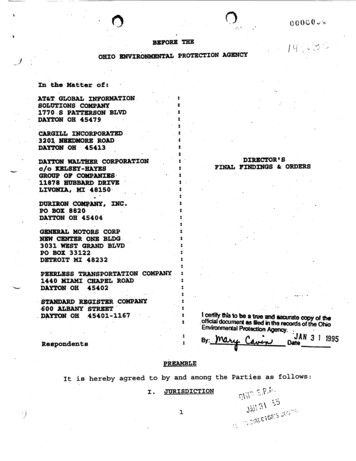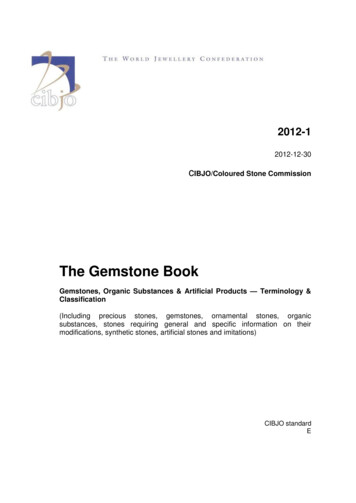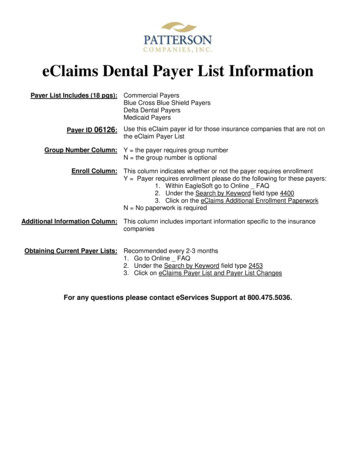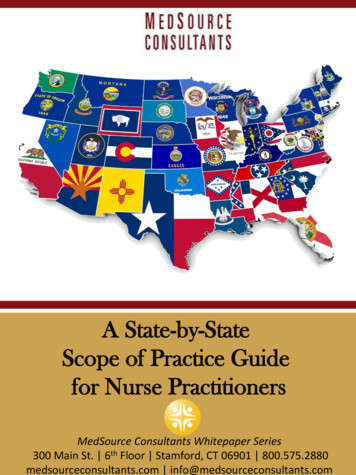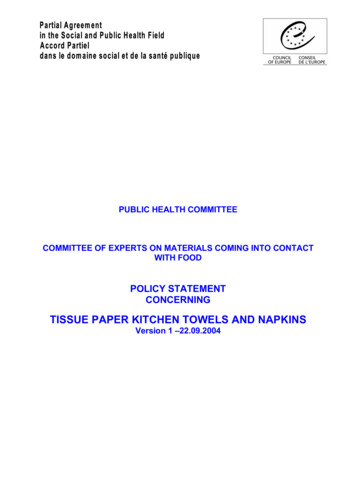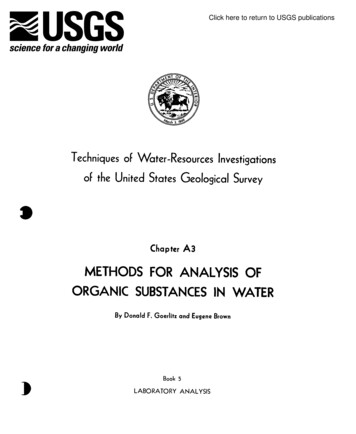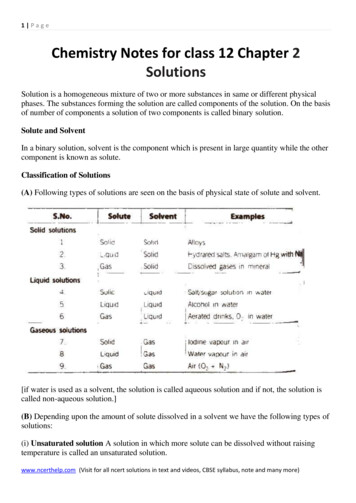
Transcription
CONTROLLED SUBSTANCESPAPERWORK BASICSPlease do not view this as an end all for information on handling your controlled substances. I am simply presenting toyou how I handle our controlled substance logging and tracking. It is as good a place as any to start.I am under the impression that the DEA has a lot of freedom/leeway when they audit you.Butler Pharmaceuticals has had a controlled substance class. Lasts about two hours and covers the basics.The system components: Internal AuditsInvoicesTransfersBackground check formsCopies of veterinary licensesDisposition LogsUsage logsFiling systemNumbering SystemFiling System The DEA requires that your controlled substance records be kept for two years. SOME STATES REQUIRE THEY BEHELD FOR THREE YEARS (CALIFORNIA FOR EXAMPLE). CHECK YOUR STATE LAWS.Our filing system consists of binders. Every year has its own binder(s).If you are using Class 2 controlled substances, you must maintain a separate system for these. DO NOT INCLUDETHEM IN A FILE OR BINDER THAT CONTAINS ANY NON-CLASS 2 CONTROLLED SUBSTANCES.Numbering System Your clinic must have some way of tracking the controlled substances that it uses. Numbering the bottles helpsyou keep on top of this.For large clinics processing lots of controlled substances color coding can make things easier. This is probably awaste of effort in small clinics. I print all disposition and usage logs on colored paper, and bottle numbers oncolor coded stickers (when possible). It makes them really easy to find and hard to confuse.o Buprenorphine Blueo Euthanasia Redo Valium Violeto Ketamine Yellowo Tealazol Tealo Torbugesic Fluorescent GreenNumbering SystemThere are three components to our numbering systemA letter that represents the drugB BuprenorphineD DiazepamE EuthanasiaK KetamineT TorbugesicTZ Telazol
A number that represents the year in which it was purchased10 201011 201112 2012The number assigned to the individual bottle. I start with001 if I am likely to use more than 100 bottles01 if I am likely to use more than 10 but less than 99 bottles1 if I am likely to use 9 bottles or lessSo:D10-075 is the 75th bottle of diazepam purchased/numbered in 2010K09-150 is the 150th bottle of ketamine purchased/numbered in 2009I use stickers to number my bottles. If processing large orders it is easy to start writing numbers more than once or to skip them. The stickerseliminate this. I place two stickers on each bottle, one on the cap and one on the body. The sticker system doesn’t save me any time overall, but it saves me time on the day that the order is received,as I prepare them in advance. My stickers are color coded (as are my disposition logs and usage logs). You can pull the stickers off the cap or the bottle and place them on your log if you choose to. Care must be taken once the bottle is in use to not remove all numbers from it.Processing Your Order/Invoices Your controlled substance order must be processed the day you receive it.Your order will come with an invoice. On the invoice you will record:o The date the shipment was received.o For each type of controlled substance you received you will record the: Number of bottles Lot number Expiration date Number assigned to the bottles “20 bottles diazepam, D10-001 to D10-020, Lot 71-215-01-EV Exp 11-2010”The invoice is then filed, I have a section in my binder marked “invoices.”The bottles are recorded in order on a disposition log.Your first Biennial audit is performed if this is your first order.The controlled substances are locked in your safe/lock box.Disposition LogsThe disposition log tells you where all bottles of controlled substances in your practice are located at any time. Itincludes the following information:
When they were receivedWho they were received from (we don’t use that many suppliers, so I just use initials)Volume in each bottleLot numberExpiration dateWhen a bottle is moved from the safe to a room in the clinic or to a clinician’s bag the date and new location arerecorded.The person responsible for the movement of the bottle initials the “by” column.All subsequent moves, if any, are recorded.When the bottle is finished a final entry is made in the disposition log stating the date the bottle was emptied.If more space is needed for a given bottle it is carried to the back page. This page does not contain the drug,volume, supplier, lot number, or expiration date as it is all recorded on the front page.Internal Audits You are required to do an audit of your stock:a. On the first day that you receive controlled substances.b. Biennially after that (once every two years).The audit must be performed during hours when no one will access the practices controlled substances, (on aday when the clinic is closed, or during off hours.)This is easier if you allow your stock to run down a little before you do it. (Don’t place a big order and thendecide to audit your stock).NOTE: There are companies that employ retired DEA officers to consult with veterinary clinics. According to one suchcompany (2nd hand information) if the DEA audits you they tend to only go back as far as your last internal audit. For thisreason I do an audit every year. I do it on the first of the year and keep my records for each year completely separate. Ido a balance forward on a new usage log for any open bottles from the previous year. I make a balance forward entryon my disposition log, and have a new disposition log that covers exactly a one year period. Under bottle numbers you can list a series, as long as the lot numbers and expiration dates are all the same forthe entire series.
D10-001 to D10-020, Lot 71-215-01-EV, Exp 11-2010Background Check Forms and Veterinary License Copies Any person who will be handling controlled substances in your clinic must sign a background check form. (Thereis no requirement that you complete the background check unless you have an Institutional license for yourfacility), but you must have the form signed. There are specific requirements for what must be included in thisform. They must include the following points: All Veterinarians working under your license/with your controlled substances must supply you with a copy oftheir current veterinary license.Transfers All controlled substance transfers (DVM to DVM) must have an accompanying signed transfer form.Both DVMs need to sign the form and file a copy in their records.This form must include the following information from both partieso DEA license numbero Expiration dateo Address of recordo Dateo SignatureThe form must also include all pertinent information regarding the controlled substances being transferred.o Drugo Bottle Number (if applicable)o Lot numbero Expiration dateo Total volume of each drug being transferred
Usage Logs Your usage logs will be your biggest source of frustration. They must include:ooooooooooooThe controlled substance typeBottle numberLot numberExpiration dateBeginning balanceBalance forward on: The end of every completed page The beginning of every new pageRemaining balance after each draw I find that a minimum of 30% of these entries are incorrect I require an adding machine tape be attached to all completed logsDate bottle placed into usePage numberFor each draw Date Patient Person who made the draw If working in a clinic with multiple clinicians, the clinician who ordered the drawA total drawn for each pageAll errors/corrections require A single line out (no scribbling over) Accompanying initials of the person recording the correction
Remember, these are legal documents!!I have two types of logs.o Multiple small draws to a single bottle typeo Multiple bottles per page for diazepam(5 bottles per page) or ketamine(5 bottles per page) use in horses
do a balance forward on a new usage log for any open bottles from the previous year. I make a balance forward entry on my disposition log, and have a new disposition log that covers exactly a one year period. Under bottle numbers you can list a series, as long as the lot numbers and
